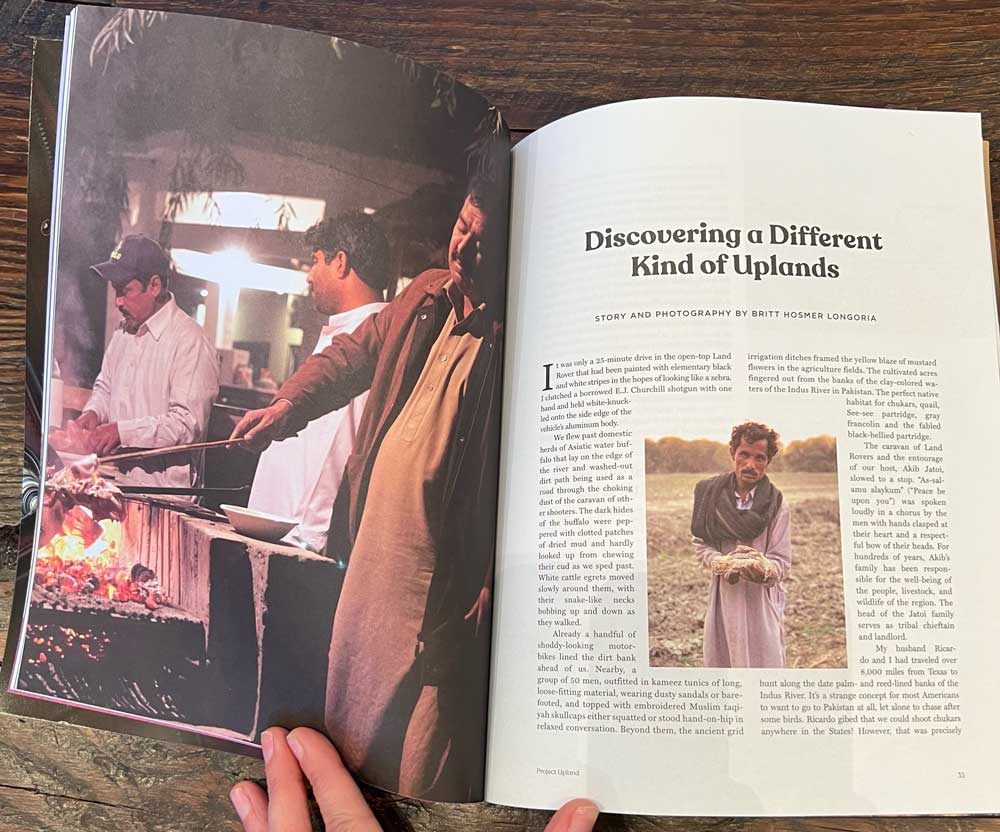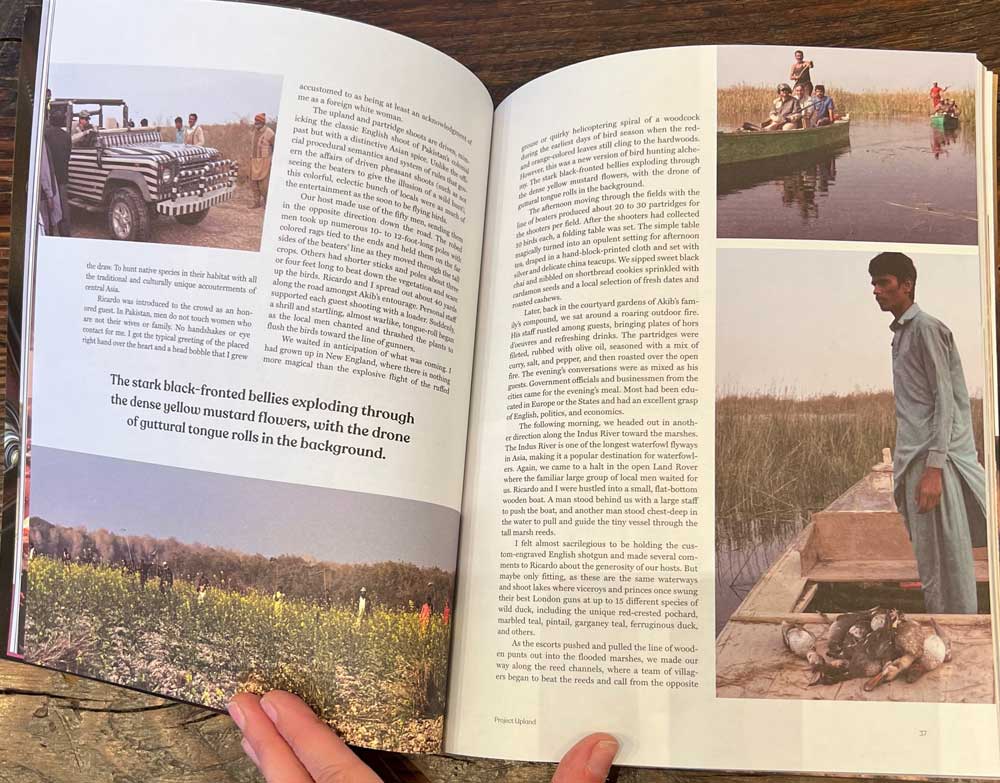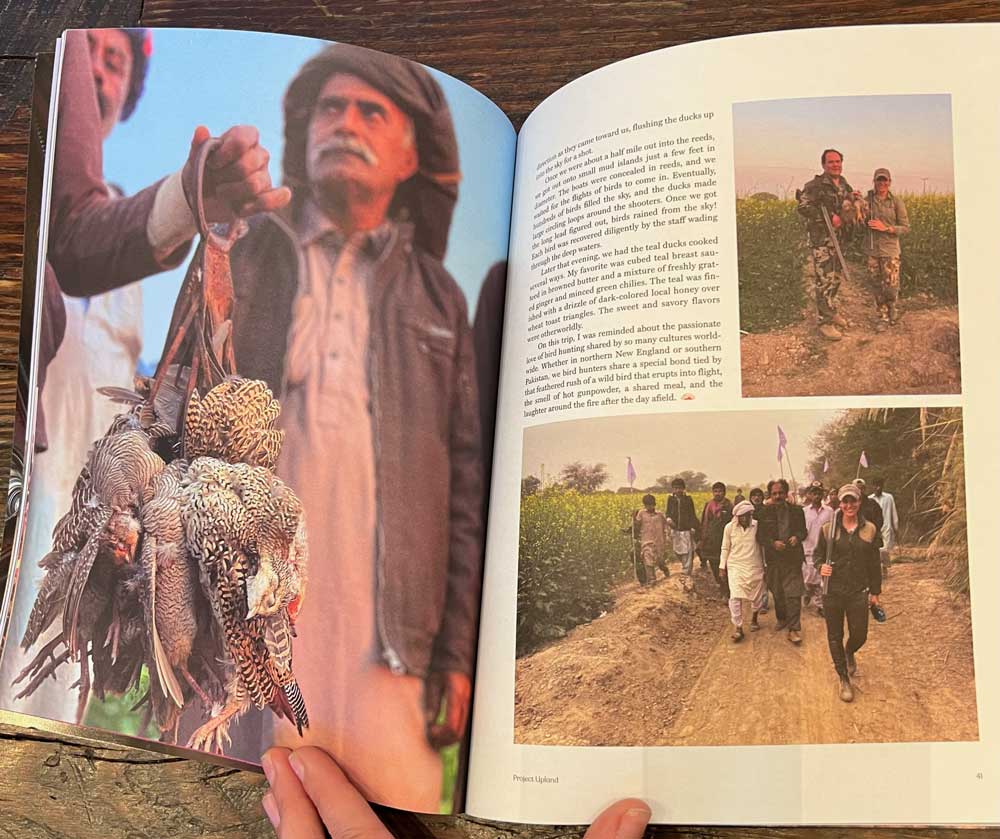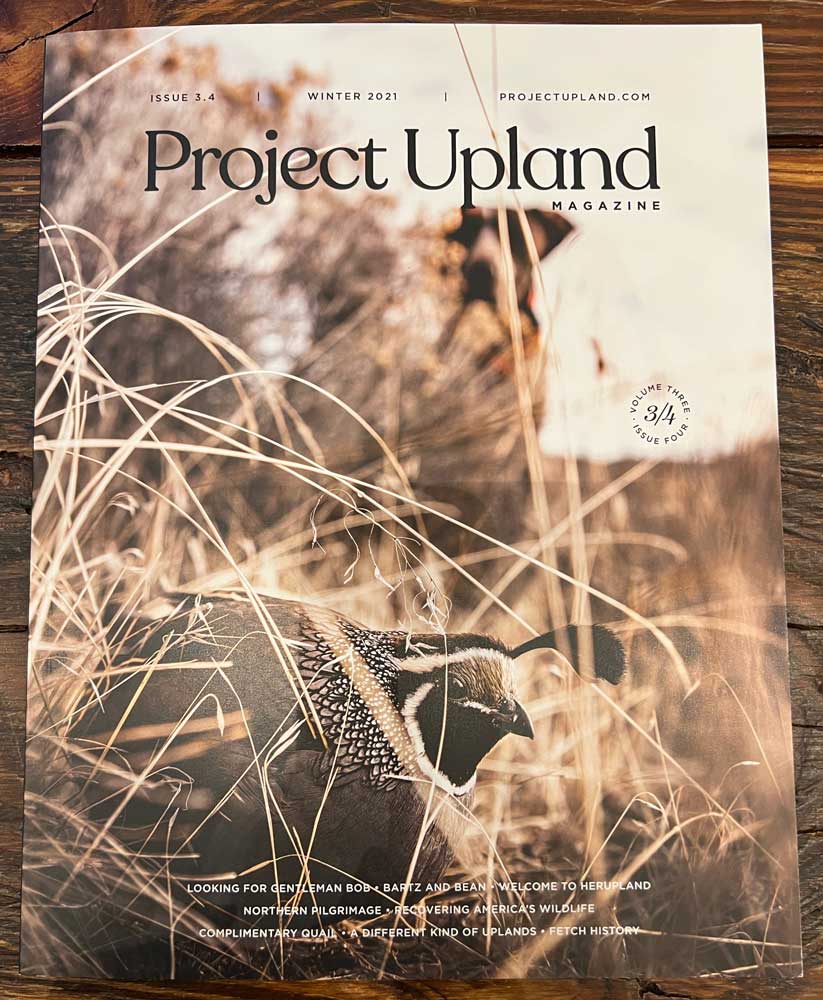Discovering a Different Kind of Upland - Published in Project Upland
Thu April 7, 2022
It was only a twenty-five-minute drive in the open-top Land Rover that had been painted with elementary black and white stripes in the hopes of looking like a zebra. I clutched a borrowed E.J. Churchill shotgun with one hand and held white-knuckled onto the side edge of the vehicle's aluminum body.
We flew past domestic herds of Asiatic water buffalo that lay on the edge of the river and washed-out dirt path being used as a road through the choking dust of the caravan of other shooters. The dark hides of the buffalo were peppered with clotted patches of dried mud and hardly looked up from chewing their cud as we sped past. White cattle egrets moved slowly around them, with their snake-like necks bobbing up and down as they walked.
Already a handful of shoddy-looking motorbikes lined the dirt bank ahead of us. Nearby a group of fifty men, outfitted in kameez tunics of loose, long fitting material, dusty sandals or barefooted, and topped with embroidered Muslim taqiyah skullcaps either sat squatted or hand-on-hip in relaxed conversation. Beyond them, the ancient grid irrigation ditches framed the yellow blaze of mustard flowers in the agriculture fields. The cultivated acres fingered out from the banks of the clay-colored waters of the Indus River in Pakistan. The perfect native habitat for chukars, quail, See-see partridge, gray francolin and the fabled black-bellied partridge.

The caravan of Land Rovers and the entourage of our host, Akib Jatoi, slowed to a stop. "As-Salamu-Alaykum" (‘Peace be upon you’) was spoken loudly in a chorus by the men with hands clasped at their heart and a respectful bow of their heads. Akib's family are the tribal chieftain and landlord of the region. As had been the custom for hundreds of years, the Jatoi's are responsible for the people's well-being and the livestock, wildlife, and wild bird populations of the region.
Ricardo, my husband, and I had traveled over 8,000 miles from Texas to hunt along the date palm and reed-lined banks of the Indus River. The concept is foreign enough for most people to want to go to Pakistan, let alone chase after some birds. Ricardo jabbed that we could shoot chukars anywhere in the States! However, that was precisely the draw. To hunt native species in their habitat with all the traditional and culturally unique accouterments of central Asia.
Ricardo was introduced to the crowd as an honored guest. In Pakistan, men do not touch women who are not their wives or family. No handshakes or eye contact for me. I got the typical greeting of the placed right hand over their heart and head bobble that I have come accustomed to being at least an acknowledgment of me being a foreign, white woman.
The upland and partridge shoots are driven, which mimic the classic English shoot of their colonial past but with distinctive Pakistani spice. Unlike the official procedural semantics and system of rules that govern the affairs of driven pheasant shoots (such as not seeing the beaters to give the impression of a wild hunt), this colorful, eclectic bunch of locals were as much of the entertainment as the soon to be flying birds!
Our host made use of the fifty men sending them in the opposite direction down the road. The robed men took up numerous ten- to twelve-foot-long poles with a colored rag tied to the end held on the far sides of the beaters' line as they moved through the tall crops. Others had shorter sticks and poles about three or four feet long to beat the vegetation down and scare up the birds. Ricardo and I spread out about forty yards along the road amongst Akib's entourage. Personal staff supported each guest shooting with a loader. Suddenly a shrill and startling, almost warlike, tongue-roll as the local men began chanting and thrashing the plants to flush the birds towards the line of gunners.

We waited in anticipation of what was coming. I had grown up in New England, where there is nothing more magical than the explosive flight of the ruffed grouse or quirky helicoptering spiral of a woodcock during the earliest days of bird season when the red- and orange-colored leaves still clung to the hardwoods. However, this was a new version of bird hunting alchemy. The stark black-fronted bellies exploding through the dense yellow mustard flowers, with the drone of guttural tongue rolls in the background.
The afternoon moving through the fields with the line of beaters produced about twenty to thirty partridges for the shooters per field. After the shooters had collected ten birds each, a folding table was set. The simple table magically turned into an opulent setting for afternoon tea. Draped in a hand-block painted cloth was set with silver and delicate china teacups. We sipped sweet black chai and nibbled on shortbread cookies sprinkled with cardamon seeds and a local selection of fresh dates and roasted cashews.
Later back in the courtyard gardens of Akib's family compound, we sat around a roaring outdoor fire. His staff rustled between guests bringing plates of hors d'oeuvres and refreshing drinks. The partridges were fileted, rubbed with olive oil, seasoned with a mix of curry, salt, and pepper, then roasted over the open fire. The evening's conversations were as mixed as his guests. Government officials and businessmen from the cities came for the evening's meal. Most had been educated in Europe or the States and had an excellent grasp of English, politics, and economics.
The following morning, we headed out in another direction along the Indus River. Towards the marshes. The Indus River is one of the longest waterfowl flyways in Asia, making it a Mecca for waterfowlers. Again, we came to a halt in the open Land Rover where the familiar large group of local men waited for us. Ricardo and I were hustled into a small flat, bottom wooden boats. A man stood behind us with a large staff to push the boat, and another man stood chest-deep in the water to pull and guide the tiny ship through the tall marsh reeds.

I felt almost sacrilegious to be holding the engraved custom English shotgun and made several comments to Ricardo about the generosity of our hosts. But maybe only fitting, as these are the same waterways and shoot lakes where Viceroys and Princes once swung their best London guns at up to fifteen different species of wild duck including the unique Red crested pochard, Marbled teal, Pintail, Garganey teal, Ferrungous duck and others.
As the escorts pushed and pulled the line of wooden canoes out into the flooded marshes, we made our way along the reed channels where a team of about villagers began to beat the reeds and called from the opposite direction coming towards us, flushing the ducks up into the sky for a shot.
Once we were about a half-mile out into the reeds, we got out onto small mud islands, about a few feet in diameter. The boats were concealed in reeds, and we waited for the flights of the birds to come in. Eventually, hundreds of birds filled the sky, and the ducks made large circling loops around the shooters. Once we got the long lead figured out, birds rained from the sky! Each bird was recovered diligently by the staff waiting through the deep waters.
Later that evening, we had the teal ducks cooked several ways. My favorite was cubed teal breast sauteed in browned butter and a mixture of freshly grated ginger and minced green chilies. The teal was finished a drizzled with dark-colored local honey over wheat toast triangles. The sweet and savory flavors were otherworldly.

On this trip, I was reminded about the passionate love of bird hunting, shared by so many cultures worldwide. Whether in northern New England or southern Pakistan, we bird hunters share a special bond tied by that feathered rush of a wild bird that erupts into flight, the smell of hot gunpowder, a shared meal, and the laughter around the fire after the day afield.
**This post was originally published in Project Upland Magazine**

Post Tags
Related Posts
- Masailand Safari - by Britt Longoria
- One Bolt Buffalo - Published in Petersen's Hunting Magazine
- Quiet Moments in Tanzania
Recent Posts
Jan 2022
- Safari Club International's Diana Award Recipient, Britt Longoria
- Coues Deer in Old Mexico - By Brittany Hosmer Longoria